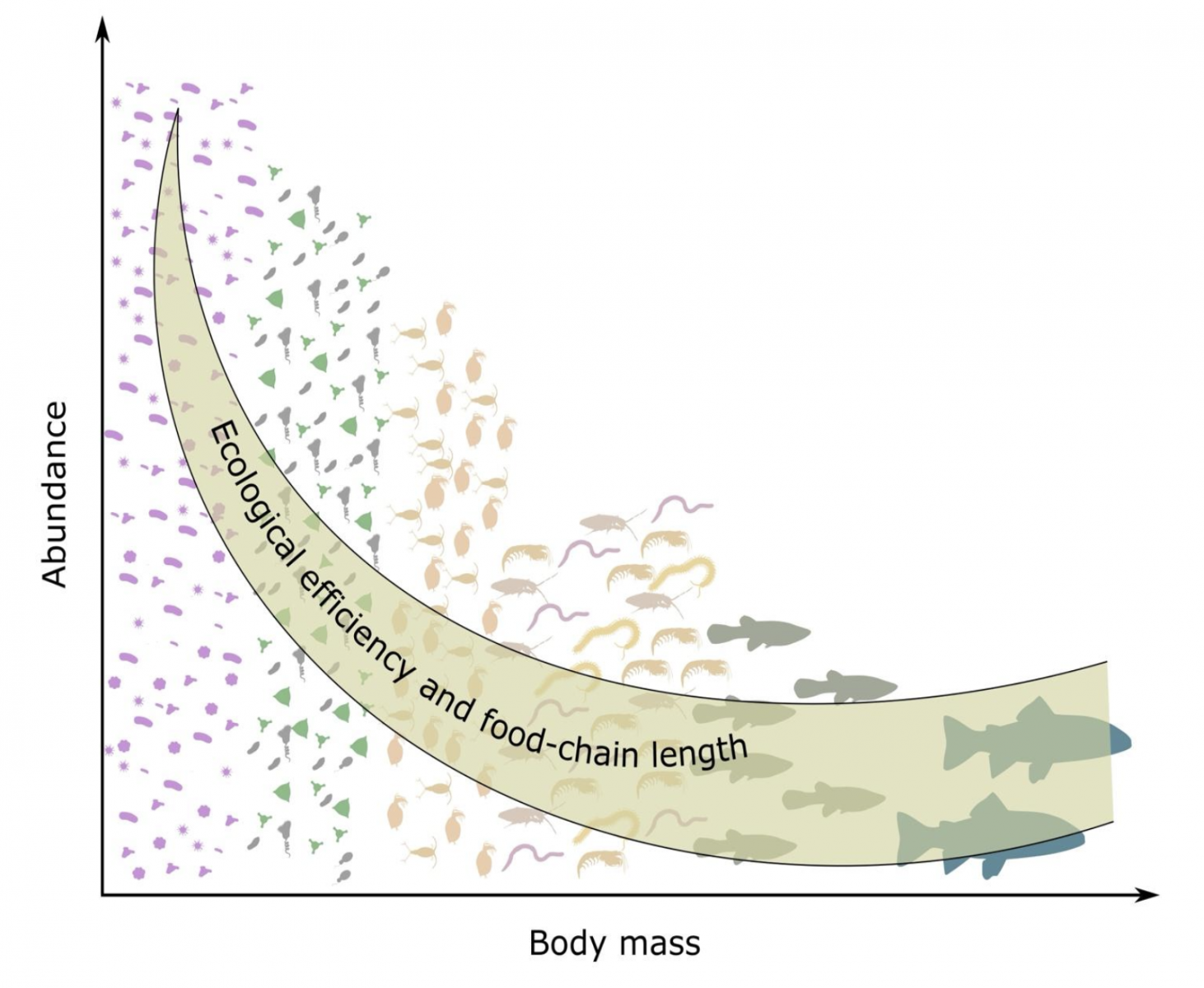Building GLOSSAQUA: the global dataset on size spectra from aquatic ecosystems
By Zeynep Ersoy, Charlotte Evangelista, Ignasi Arranz, and collaborators
 From microbes to megafauna, body size spans 21 orders of magnitude. In nature, a consistent pattern emerges in which smaller organisms at the base of the food chain (e.g., phytoplankton) outnumber their larger counterparts located at the top (e.g., fish). Such a norm was earlier reflected in the upright “pyramid of numbers” proposed by Charles Elton in 1927, which represents the relative abundance of organisms at each trophic level. Derived from Elton's pyramid, the size spectrum was first coined by marine ecologists already in 1962, representing the relationship between abundance or biomass and body size in communities. This relationship generally shows that the smaller is the size of an organism, the higher is its abundance or biomass. Since the 1960s, scientists have studied how energy moves through food chains and how this affects the number of organisms of different sizes. Previous theoretical works have linked changes in size and abundance with how energy is transferred from one level of the food web to the next. The size spectrum has become a central concept in ecosystem ecology, particularly in aquatic ecology, and variations in its parameters have been used as key indicators of how biological communities respond to global change drivers such as species overexploitation and water temperature increase. Despite its widespread use, we lacked a global dataset compiling key variables of the size spectrum from diverse aquatic ecosystems and different organisms, which is essential to make cross-ecosystem comparisons across different groups of organisms globally.
From microbes to megafauna, body size spans 21 orders of magnitude. In nature, a consistent pattern emerges in which smaller organisms at the base of the food chain (e.g., phytoplankton) outnumber their larger counterparts located at the top (e.g., fish). Such a norm was earlier reflected in the upright “pyramid of numbers” proposed by Charles Elton in 1927, which represents the relative abundance of organisms at each trophic level. Derived from Elton's pyramid, the size spectrum was first coined by marine ecologists already in 1962, representing the relationship between abundance or biomass and body size in communities. This relationship generally shows that the smaller is the size of an organism, the higher is its abundance or biomass. Since the 1960s, scientists have studied how energy moves through food chains and how this affects the number of organisms of different sizes. Previous theoretical works have linked changes in size and abundance with how energy is transferred from one level of the food web to the next. The size spectrum has become a central concept in ecosystem ecology, particularly in aquatic ecology, and variations in its parameters have been used as key indicators of how biological communities respond to global change drivers such as species overexploitation and water temperature increase. Despite its widespread use, we lacked a global dataset compiling key variables of the size spectrum from diverse aquatic ecosystems and different organisms, which is essential to make cross-ecosystem comparisons across different groups of organisms globally.To fill in this gap, we conducted an extensive literature review to construct the most comprehensive collection of size spectrum parameters across different marine (52% of the studies), freshwater (43%), and brackish (5%) communities, ranging from single (e.g., zooplankton, macroinvertebrates or fish) to multiple taxonomic groups (e.g., from primary consumers to apex predators, and phytoplankton to large zooplankton). The resulting GLOSSAQUA dataset includes information on the body size structure obtained from 135 studies (including published articles and grey literature). For each article, we also included the geographical coordinates and ecological information of the study sites, such as the presence of pollution or non-native species, as well as methodological information on how the different studies calculated the size spectrum.
For us, Zeynep Ersoy, Charlotte Evangelista, and Ignasi Arranz, building the GLOSSAQUA dataset was a great experience as it was our first project as principal investigators, thanks to the funding from the SIBECOL ECR Grants. Our project would not have been successful without the contributions of many field ecologists who shared their data with us. Although our journey began with just the three of us, GLOSSAQUA is the result of an international group of more than 40 coauthors from 12 countries. Looking ahead, we believe that our work will open new research avenues to explore the responses of community size structure to environmental changes at a global scale, which is rarely explored in size spectrum ecology. It is fundamental to explore questions such as factors influencing spatial and temporal dynamics of community size structure, comparing the response of community size structure between natural versus human-impacted sites, and global patterns in different aquatic ecosystems.
Read the full study here:
Ersoy, Zeynep, Charlotte Evangelista, Aitor Larrañaga, Daniel M. Perkins, Javier Sánchez-Hernández, Teofana Chonova, David Cunillera-Montcusí, et al. 2025. “ GLOSSAQUA: A Global Dataset of Size Spectra across Aquatic Ecosystems.” Ecology 106(3): e70050. https://doi.org/10.1002/ecy.70050
Text written by Zeynep Ersoy, Charlotte Evangelista, Ignasi Arranz and edited by Clara Ruiz and Félix Picazo
